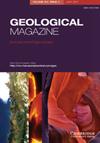西帕米亚山脉(阿根廷)志留系逆巴罗维亚型变质作用:一个自上而下加热的例子?
IF 2
3区 地球科学
Q3 GEOSCIENCES, MULTIDISCIPLINARY
引用次数: 0
摘要
摘要本文重点研究了一条造山带,该造山带形成于445至410 Ma之间的法马廷造山运动最后阶段的Rinconada阶段,在阿根廷西部的Sierra de Ramaditas和邻近山脉中暴露良好。Ramaditas杂岩由变质沉积岩、变质超基性岩和角闪岩组成。该杂岩形成了西向逆冲作用形成的逆冲叠层的上部推覆体。变形由早期高温S1叶理(闪变混合岩)组成,与逆冲作用和变质作用同时发生。变质作用在约440 Ma时达到了6.0–6.9 kbar和795–810°C的峰值P–T条件,即与Rinconada造山相一致。下部单元和中间推覆体在附近的Maz和Espinal山脉中突出,分别经历了低至中等级别的志留纪变质作用,以及上部推覆体,定义了反向巴罗型变质作用,T在逆冲叠层中向下(即向西)增加,P在下降。我们认为,Rinconada造山期在冈瓦纳大陆西南部大陆边缘附近发育,在约470 Ma前柯迪拉地体向大陆边缘吸积后的岩浆平静期。吸积后活动边缘向西跳跃,志留纪早期恢复了平板俯冲,在较老的法马汀期岩浆弧的高温根部(800–900°C)下引发推覆岩堆的逆冲和叠瓦作用。这种“热铁”过程解释了反向巴罗型变质作用和P估计所暗示的21至24km的覆盖层缺失。本文章由计算机程序翻译,如有差异,请以英文原文为准。
Silurian inverted Barrovian-type metamorphism in the Western Sierras Pampeanas (Argentina): a case of top to bottom heating?
Abstract This paper focuses on one orogenic belt that formed during the Rinconada phase on the final stage of the Famatinian orogeny, between 445 and 410 Ma, which is well exposed at Sierra de Ramaditas and neighbouring ranges in western Argentina. The Ramaditas Complex is formed by metasedimentary and meta-ultrabasic rocks and amphibolites. This complex forms the upper nappe of a thrust stack resulting from westward thrusting. Deformation consists of an early high-temperature S1 foliation (stromatic migmatites), coeval with thrusting and metamorphism. Metamorphism attained peak P–T conditions of 6.0–6.9 kbar and 795–810 °C, at c. 440 Ma, i.e. coincident with the Rinconada orogenic phase. The lower unit and intermediate nappes crop out in the nearby sierras of Maz and Espinal and underwent low- to medium-grade Silurian metamorphism, respectively, together with the upper nappe, defining an inverted Barrovian-type metamorphism with T decreasing and P increasing downwards across the thrust stack (i.e. westward). We argue that the Rinconada orogenic phase developed near the continental margin of SW Gondwana, during a magmatic lull following accretion of the Precordillera terrane to the continental margin at c. 470 Ma. The active margin jumped to the west after accretion, and flat-slab subduction resumed in the early Silurian, provoking thrusting and imbrication of nappe stack under the still hot root (800–900 °C) of the older Famatinian magmatic arc. This ‘hot-iron’ process explains both the inverted Barrovian-type metamorphism and the missing overburden of 21 to 24 km implied by the P estimate.
求助全文
通过发布文献求助,成功后即可免费获取论文全文。
去求助
来源期刊

Geological Magazine
地学-地球科学综合
CiteScore
4.70
自引率
0.00%
发文量
111
审稿时长
3 months
期刊介绍:
Geological Magazine, established in 1864, is one of the oldest and best-known periodicals in earth sciences. It publishes original scientific papers covering the complete spectrum of geological topics, with high quality illustrations. Its worldwide circulation and high production values, combined with Rapid Communications and Book Review sections keep the journal at the forefront of the field.
This journal is included in the Cambridge Journals open access initiative, Cambridge Open Option.
 求助内容:
求助内容: 应助结果提醒方式:
应助结果提醒方式:


